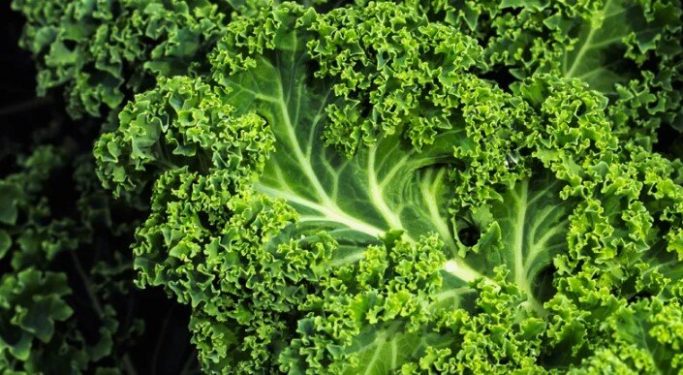Kale, also known as leaf cabbage, is one of the Brassica oleracea Acephala group cultivars that also has spring greens and collard greens. Other B. oleracea cultivars include cabbage, cauliflower, broccoli, broccolini, Brussels sprouts, and kohlrabi, among many others.
This popular edible vegetable with some varieties being ornamental belongs to the cabbage, mustard, or crucifers family, otherwise known as family Brassicaceae. It doesn’t have a head-like center like cabbage, and its leaves can be green, reddish, or purple.
Common varieties of kale include plain leaf that has the red and white Russian kale, curly-leaf (scot, blue or curled leaves kale). Also, there is the bumpy leave (Cavolo Nero, Lacinato, Tuscan cabbage, Tuscan kale or dinosaur kale), as well as the leaf and spear that serves mainly as an ornamental plant since its leaves are tough making it less palatable.

Is kale good for bunnies, can they eat it?
Yes. Rabbits can eat kale, including the curly kale, Cavolo Nero (Italian), red (Russian), as well as its stalks or stems and baby kale. Indeed, all types of kale are safe and will not harm your pet.
Nutritionally, this veggie is rich in vitamin A, C, K, folate, and manganese. It also has magnesium, riboflavin, thiamine, pantothenic acid, vitamin B6, magnesium, potassium, calcium, iron, phosphorus, vitamin E, and so on.
Most bunnies like kales and will enjoy eating it. Even in the wild, they may, from time to time, nibble this vegetable. However, it isn’t their most preferred. They will eat more of flowers like roses, tulips, phlox, impatiens, petunias, roses, zinnias, rose moss, pansies, hostas, asters, and so forth.
In your garden, they will prefer lettuce, clovers, peas, beans, strawberries, grapes, beet greens, spinach, broccoli, apples, among other plants.
How much kale is enough?
On quantities, feed them like any other leafy vegetable, i.e., chop it together with other 4-5 veggies to make a vegetable mix. Two cups of this mix will be sufficient for a rabbit whose weight is four pounds.
Is it high in oxalates?
Most people often wrongfully implicate kale saying it is high in oxalic acid (oxalates) and recommend that bunnies have it sparingly. This insinuation is not the case. The US Department of Agriculture USDA (1984) note this vegetable has 20 mg of oxalates per 100g.
Furthermore, a 2008 research by the Department of Nutrition at the Harvard School of Public Health puts the amount of oxalic acid at 3mg per 100g. Rabbit.org, a non-profit rabbit rescue as well as an educational organization, shares similar sentiments on oxalate levels.
We understand that oxalates will increase the chances of urinary bladder stones and reduces the absorption of minerals as they bind with these minerals. If the binding occurs in their stomach, there may be other gastrointestinal problems.
Therefore, besides the need to vary the various foods you feed your rabbits, there is no problem even if bunnies eat kale every day, it will not harm them.
How to feed bunnies kale?
It is evident that this all varieties of leafy vegetable is safe for rabbits. However, like any other greens, you need to know how to feed them properly. An excessive amount of any fresh plant material may result in tummy issues like bloating, gas, constipation, diarrhea, and so on.
The stomach upsets are due to the relatively low fiber it has as opposed to grass hay that should account for over 80% of their diet. Therefore, don’t overfeed them any fresh plant materials. Keep their amount to 10-15% while the remainder can be pellets like Oxbow Adult Rabbit Pet Food.
Fiber helps in promoting gut motility as well as wearing your rabbit’s teeth that continuously grow.
Secondly, only feed them uncooked kale or foods. Even while in the wild, these pets never eat anything cooked. Cooking degrades nutrients, and it may modify the fibrous cell structure of any plant material, reducing fiber content. However, there is no problem with frozen kales. Just let them thaw naturally.
Furthermore, always ensure your source doesn’t have any pesticides or herbicides and wash it under running water to remove any remaining chemicals that may harm your bunny.
Finally, ensure you know how to introduce your rabbit to any new food properly. The introduction happens with only one type at a time for over at least a week. Begin with a small amount the first time, wait for a day to see if there are not stomach upsets before gradually increasing the amount.
Conclusion
Kale is not ‘bad’ or ‘harmful’ to rabbits. It isn’t high oxalates. However, it is slightly her in calcium, and a large amount is not appropriate for bunnies with urinary stone or kidney problems besides stomach upsets as already seen.
However, if you follow the right feeding guidelines discussed above, nothing more should worry you.
